Community Work and Development: Gender Inequality in Kikuyu
VerifiedAdded on 2021/06/16
|9
|2333
|14
Report
AI Summary
This report examines gender inequality within the Kikuyu community, a tribe in Kenya, highlighting the historical prevalence of gender imbalance influenced by cultural norms and societal structures. The report employs a feminist framework to analyze the issue, advocating for change through practical actions such as campaigns, empowerment programs, and education. It addresses the impact of media representations and the importance of social inclusion to combat gender discrimination. The expected outcomes include the eradication of gender discrimination, increased respect for women, and a shift in community perceptions. The paper suggests strategies to foster equality and empower women by challenging traditional gender roles and promoting their participation in all aspects of community life. The report emphasizes the need to address misconceptions and myths related to gender to foster a more equitable society, and it provides references to support its arguments.
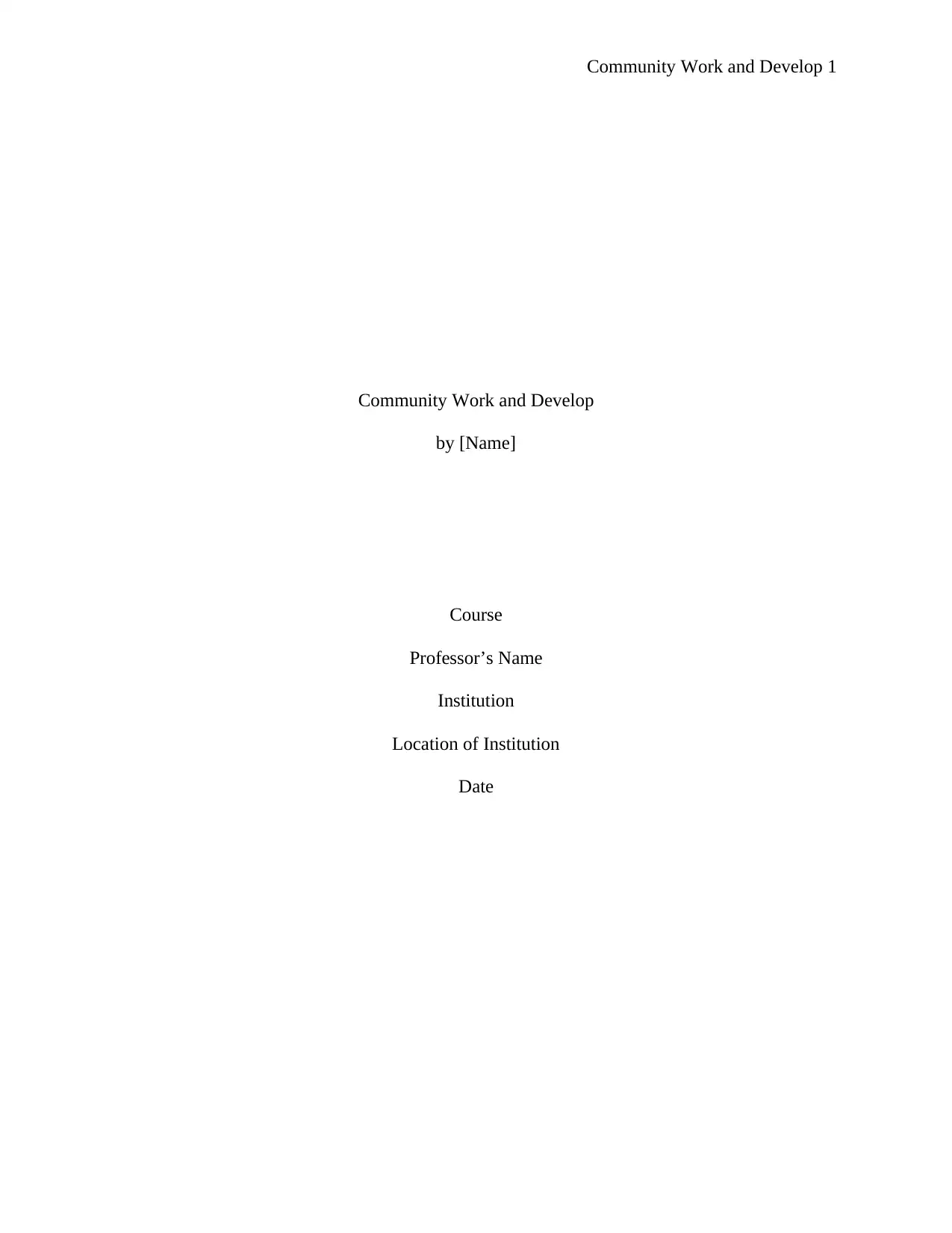
Community Work and Develop 1
Community Work and Develop
by [Name]
Course
Professor’s Name
Institution
Location of Institution
Date
Community Work and Develop
by [Name]
Course
Professor’s Name
Institution
Location of Institution
Date
Paraphrase This Document
Need a fresh take? Get an instant paraphrase of this document with our AI Paraphraser
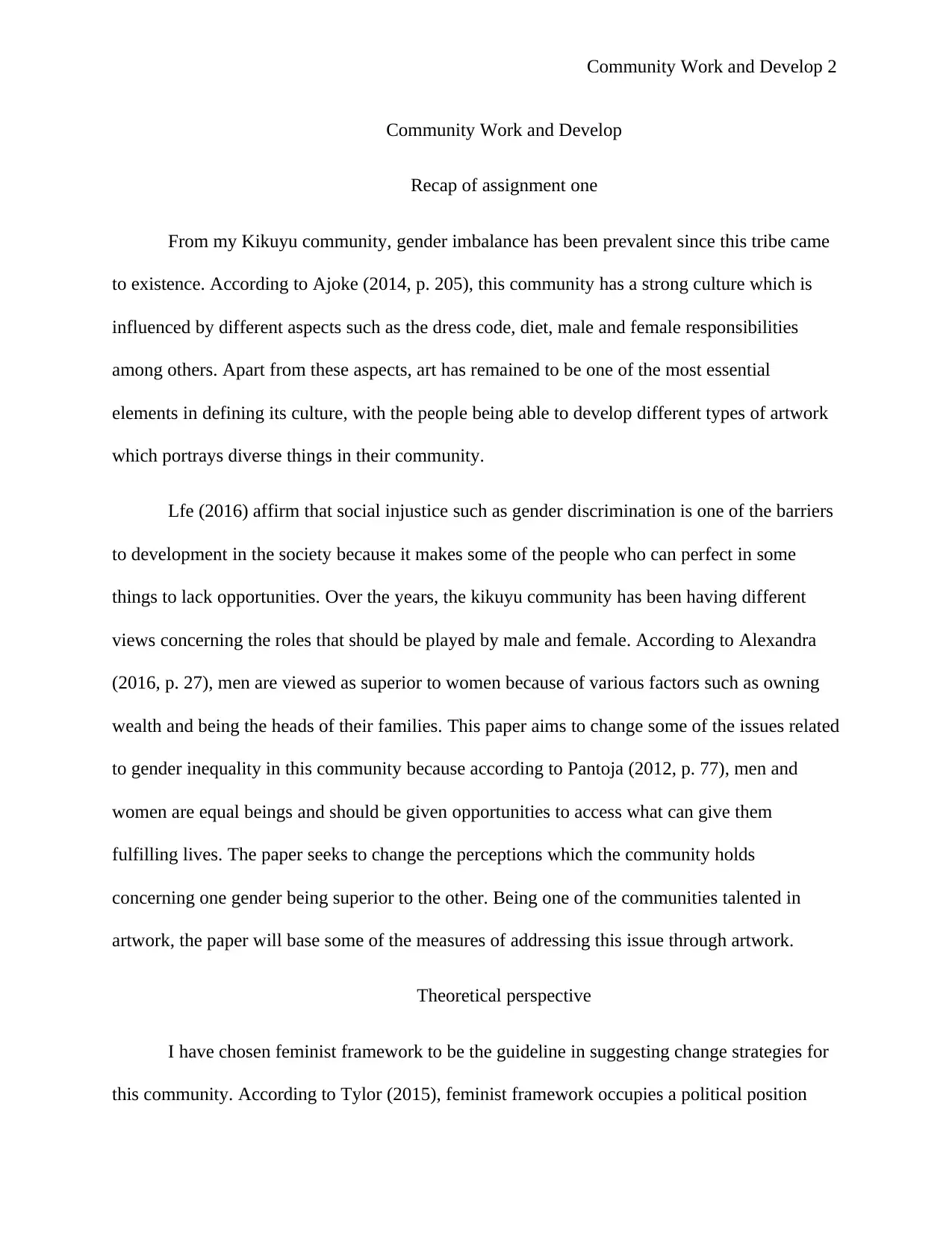
Community Work and Develop 2
Community Work and Develop
Recap of assignment one
From my Kikuyu community, gender imbalance has been prevalent since this tribe came
to existence. According to Ajoke (2014, p. 205), this community has a strong culture which is
influenced by different aspects such as the dress code, diet, male and female responsibilities
among others. Apart from these aspects, art has remained to be one of the most essential
elements in defining its culture, with the people being able to develop different types of artwork
which portrays diverse things in their community.
Lfe (2016) affirm that social injustice such as gender discrimination is one of the barriers
to development in the society because it makes some of the people who can perfect in some
things to lack opportunities. Over the years, the kikuyu community has been having different
views concerning the roles that should be played by male and female. According to Alexandra
(2016, p. 27), men are viewed as superior to women because of various factors such as owning
wealth and being the heads of their families. This paper aims to change some of the issues related
to gender inequality in this community because according to Pantoja (2012, p. 77), men and
women are equal beings and should be given opportunities to access what can give them
fulfilling lives. The paper seeks to change the perceptions which the community holds
concerning one gender being superior to the other. Being one of the communities talented in
artwork, the paper will base some of the measures of addressing this issue through artwork.
Theoretical perspective
I have chosen feminist framework to be the guideline in suggesting change strategies for
this community. According to Tylor (2015), feminist framework occupies a political position
Community Work and Develop
Recap of assignment one
From my Kikuyu community, gender imbalance has been prevalent since this tribe came
to existence. According to Ajoke (2014, p. 205), this community has a strong culture which is
influenced by different aspects such as the dress code, diet, male and female responsibilities
among others. Apart from these aspects, art has remained to be one of the most essential
elements in defining its culture, with the people being able to develop different types of artwork
which portrays diverse things in their community.
Lfe (2016) affirm that social injustice such as gender discrimination is one of the barriers
to development in the society because it makes some of the people who can perfect in some
things to lack opportunities. Over the years, the kikuyu community has been having different
views concerning the roles that should be played by male and female. According to Alexandra
(2016, p. 27), men are viewed as superior to women because of various factors such as owning
wealth and being the heads of their families. This paper aims to change some of the issues related
to gender inequality in this community because according to Pantoja (2012, p. 77), men and
women are equal beings and should be given opportunities to access what can give them
fulfilling lives. The paper seeks to change the perceptions which the community holds
concerning one gender being superior to the other. Being one of the communities talented in
artwork, the paper will base some of the measures of addressing this issue through artwork.
Theoretical perspective
I have chosen feminist framework to be the guideline in suggesting change strategies for
this community. According to Tylor (2015), feminist framework occupies a political position
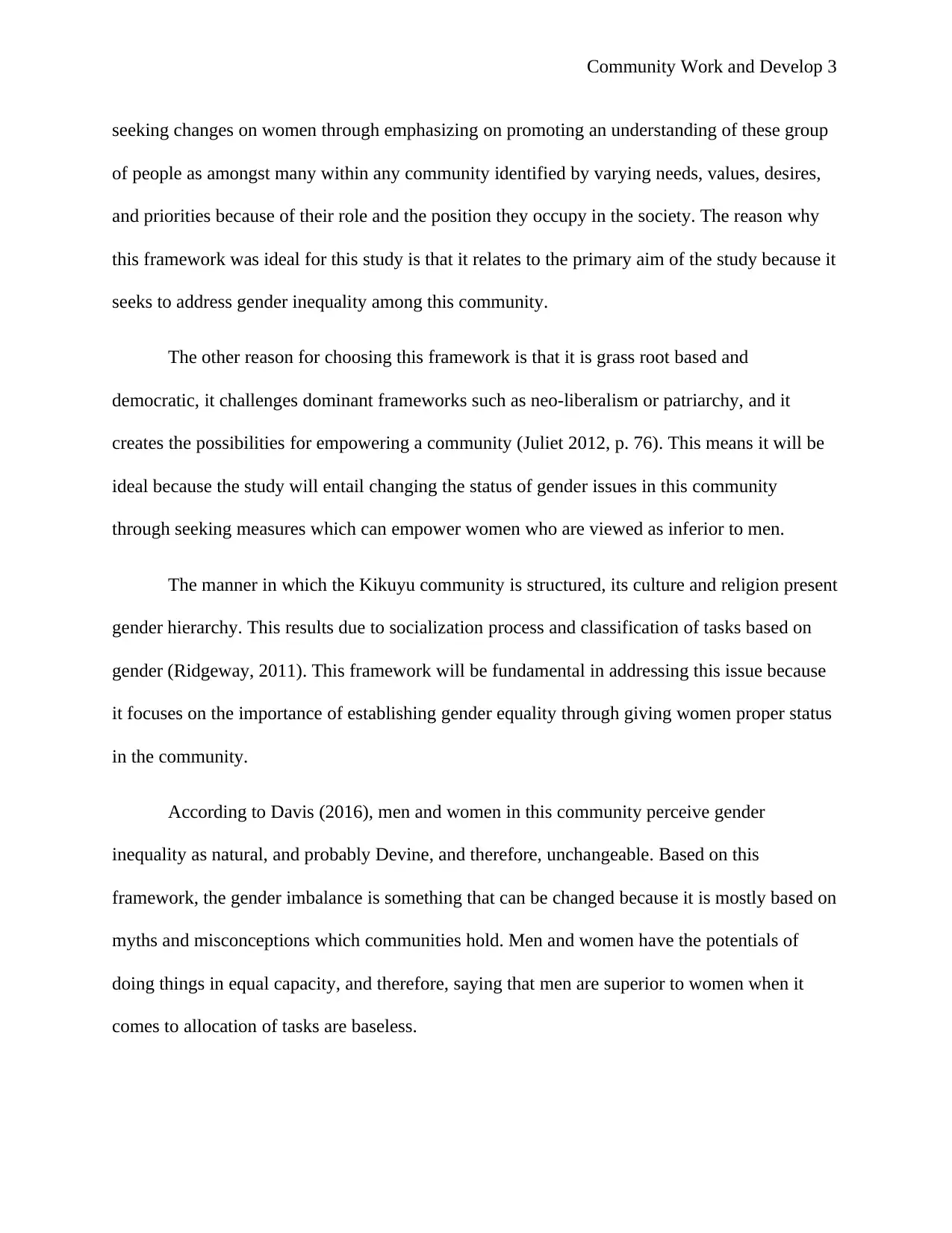
Community Work and Develop 3
seeking changes on women through emphasizing on promoting an understanding of these group
of people as amongst many within any community identified by varying needs, values, desires,
and priorities because of their role and the position they occupy in the society. The reason why
this framework was ideal for this study is that it relates to the primary aim of the study because it
seeks to address gender inequality among this community.
The other reason for choosing this framework is that it is grass root based and
democratic, it challenges dominant frameworks such as neo-liberalism or patriarchy, and it
creates the possibilities for empowering a community (Juliet 2012, p. 76). This means it will be
ideal because the study will entail changing the status of gender issues in this community
through seeking measures which can empower women who are viewed as inferior to men.
The manner in which the Kikuyu community is structured, its culture and religion present
gender hierarchy. This results due to socialization process and classification of tasks based on
gender (Ridgeway, 2011). This framework will be fundamental in addressing this issue because
it focuses on the importance of establishing gender equality through giving women proper status
in the community.
According to Davis (2016), men and women in this community perceive gender
inequality as natural, and probably Devine, and therefore, unchangeable. Based on this
framework, the gender imbalance is something that can be changed because it is mostly based on
myths and misconceptions which communities hold. Men and women have the potentials of
doing things in equal capacity, and therefore, saying that men are superior to women when it
comes to allocation of tasks are baseless.
seeking changes on women through emphasizing on promoting an understanding of these group
of people as amongst many within any community identified by varying needs, values, desires,
and priorities because of their role and the position they occupy in the society. The reason why
this framework was ideal for this study is that it relates to the primary aim of the study because it
seeks to address gender inequality among this community.
The other reason for choosing this framework is that it is grass root based and
democratic, it challenges dominant frameworks such as neo-liberalism or patriarchy, and it
creates the possibilities for empowering a community (Juliet 2012, p. 76). This means it will be
ideal because the study will entail changing the status of gender issues in this community
through seeking measures which can empower women who are viewed as inferior to men.
The manner in which the Kikuyu community is structured, its culture and religion present
gender hierarchy. This results due to socialization process and classification of tasks based on
gender (Ridgeway, 2011). This framework will be fundamental in addressing this issue because
it focuses on the importance of establishing gender equality through giving women proper status
in the community.
According to Davis (2016), men and women in this community perceive gender
inequality as natural, and probably Devine, and therefore, unchangeable. Based on this
framework, the gender imbalance is something that can be changed because it is mostly based on
myths and misconceptions which communities hold. Men and women have the potentials of
doing things in equal capacity, and therefore, saying that men are superior to women when it
comes to allocation of tasks are baseless.
⊘ This is a preview!⊘
Do you want full access?
Subscribe today to unlock all pages.

Trusted by 1+ million students worldwide
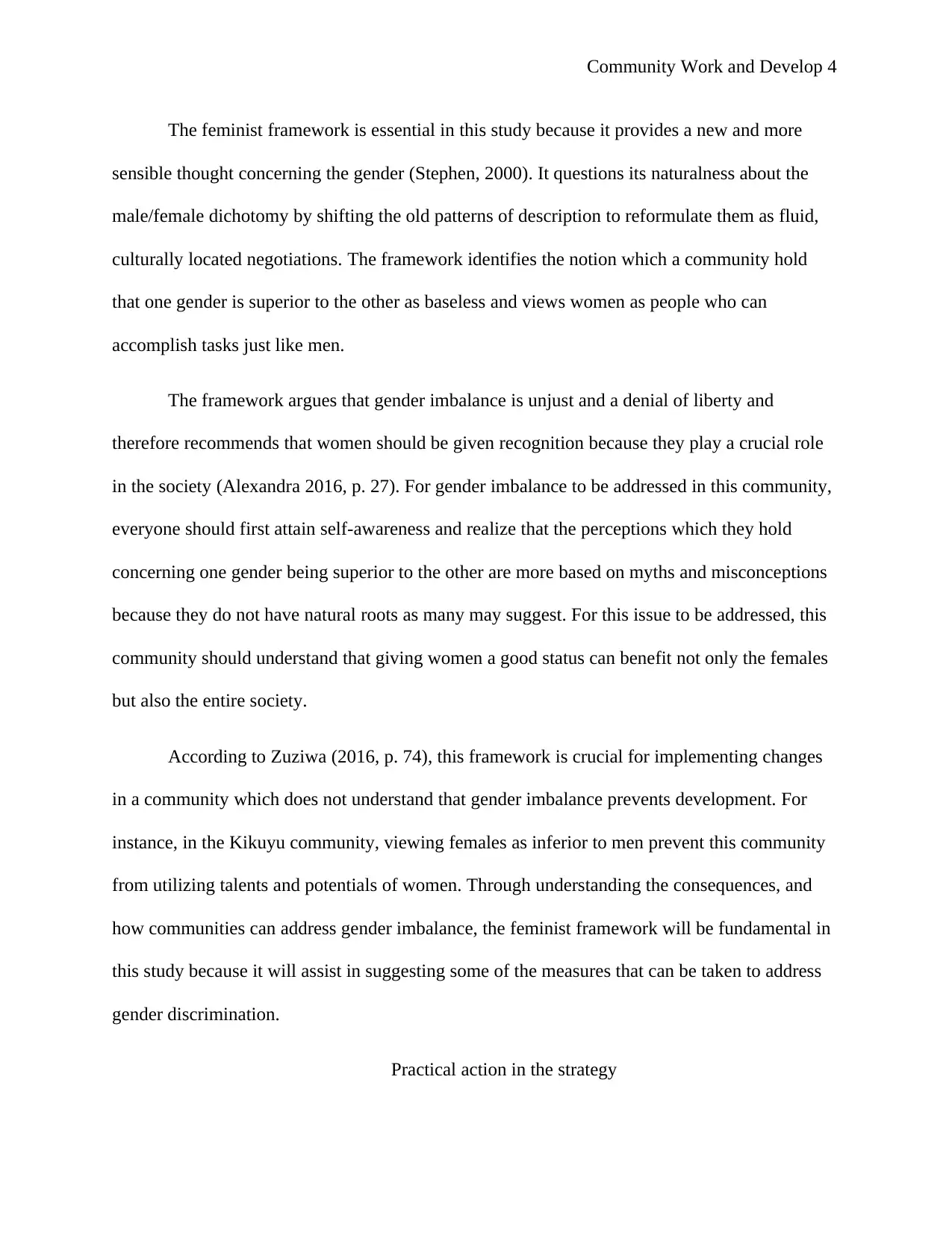
Community Work and Develop 4
The feminist framework is essential in this study because it provides a new and more
sensible thought concerning the gender (Stephen, 2000). It questions its naturalness about the
male/female dichotomy by shifting the old patterns of description to reformulate them as fluid,
culturally located negotiations. The framework identifies the notion which a community hold
that one gender is superior to the other as baseless and views women as people who can
accomplish tasks just like men.
The framework argues that gender imbalance is unjust and a denial of liberty and
therefore recommends that women should be given recognition because they play a crucial role
in the society (Alexandra 2016, p. 27). For gender imbalance to be addressed in this community,
everyone should first attain self-awareness and realize that the perceptions which they hold
concerning one gender being superior to the other are more based on myths and misconceptions
because they do not have natural roots as many may suggest. For this issue to be addressed, this
community should understand that giving women a good status can benefit not only the females
but also the entire society.
According to Zuziwa (2016, p. 74), this framework is crucial for implementing changes
in a community which does not understand that gender imbalance prevents development. For
instance, in the Kikuyu community, viewing females as inferior to men prevent this community
from utilizing talents and potentials of women. Through understanding the consequences, and
how communities can address gender imbalance, the feminist framework will be fundamental in
this study because it will assist in suggesting some of the measures that can be taken to address
gender discrimination.
Practical action in the strategy
The feminist framework is essential in this study because it provides a new and more
sensible thought concerning the gender (Stephen, 2000). It questions its naturalness about the
male/female dichotomy by shifting the old patterns of description to reformulate them as fluid,
culturally located negotiations. The framework identifies the notion which a community hold
that one gender is superior to the other as baseless and views women as people who can
accomplish tasks just like men.
The framework argues that gender imbalance is unjust and a denial of liberty and
therefore recommends that women should be given recognition because they play a crucial role
in the society (Alexandra 2016, p. 27). For gender imbalance to be addressed in this community,
everyone should first attain self-awareness and realize that the perceptions which they hold
concerning one gender being superior to the other are more based on myths and misconceptions
because they do not have natural roots as many may suggest. For this issue to be addressed, this
community should understand that giving women a good status can benefit not only the females
but also the entire society.
According to Zuziwa (2016, p. 74), this framework is crucial for implementing changes
in a community which does not understand that gender imbalance prevents development. For
instance, in the Kikuyu community, viewing females as inferior to men prevent this community
from utilizing talents and potentials of women. Through understanding the consequences, and
how communities can address gender imbalance, the feminist framework will be fundamental in
this study because it will assist in suggesting some of the measures that can be taken to address
gender discrimination.
Practical action in the strategy
Paraphrase This Document
Need a fresh take? Get an instant paraphrase of this document with our AI Paraphraser
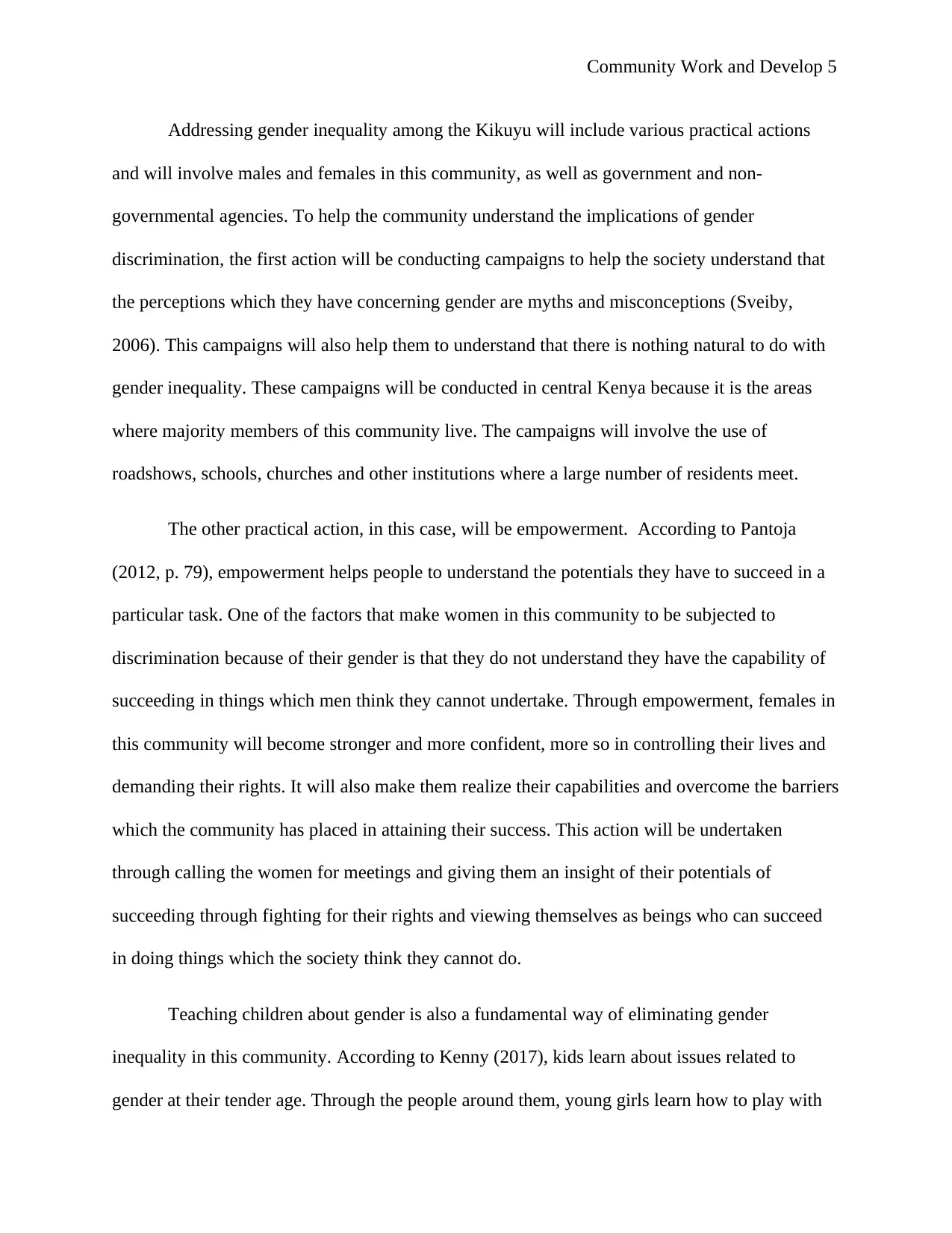
Community Work and Develop 5
Addressing gender inequality among the Kikuyu will include various practical actions
and will involve males and females in this community, as well as government and non-
governmental agencies. To help the community understand the implications of gender
discrimination, the first action will be conducting campaigns to help the society understand that
the perceptions which they have concerning gender are myths and misconceptions (Sveiby,
2006). This campaigns will also help them to understand that there is nothing natural to do with
gender inequality. These campaigns will be conducted in central Kenya because it is the areas
where majority members of this community live. The campaigns will involve the use of
roadshows, schools, churches and other institutions where a large number of residents meet.
The other practical action, in this case, will be empowerment. According to Pantoja
(2012, p. 79), empowerment helps people to understand the potentials they have to succeed in a
particular task. One of the factors that make women in this community to be subjected to
discrimination because of their gender is that they do not understand they have the capability of
succeeding in things which men think they cannot undertake. Through empowerment, females in
this community will become stronger and more confident, more so in controlling their lives and
demanding their rights. It will also make them realize their capabilities and overcome the barriers
which the community has placed in attaining their success. This action will be undertaken
through calling the women for meetings and giving them an insight of their potentials of
succeeding through fighting for their rights and viewing themselves as beings who can succeed
in doing things which the society think they cannot do.
Teaching children about gender is also a fundamental way of eliminating gender
inequality in this community. According to Kenny (2017), kids learn about issues related to
gender at their tender age. Through the people around them, young girls learn how to play with
Addressing gender inequality among the Kikuyu will include various practical actions
and will involve males and females in this community, as well as government and non-
governmental agencies. To help the community understand the implications of gender
discrimination, the first action will be conducting campaigns to help the society understand that
the perceptions which they have concerning gender are myths and misconceptions (Sveiby,
2006). This campaigns will also help them to understand that there is nothing natural to do with
gender inequality. These campaigns will be conducted in central Kenya because it is the areas
where majority members of this community live. The campaigns will involve the use of
roadshows, schools, churches and other institutions where a large number of residents meet.
The other practical action, in this case, will be empowerment. According to Pantoja
(2012, p. 79), empowerment helps people to understand the potentials they have to succeed in a
particular task. One of the factors that make women in this community to be subjected to
discrimination because of their gender is that they do not understand they have the capability of
succeeding in things which men think they cannot undertake. Through empowerment, females in
this community will become stronger and more confident, more so in controlling their lives and
demanding their rights. It will also make them realize their capabilities and overcome the barriers
which the community has placed in attaining their success. This action will be undertaken
through calling the women for meetings and giving them an insight of their potentials of
succeeding through fighting for their rights and viewing themselves as beings who can succeed
in doing things which the society think they cannot do.
Teaching children about gender is also a fundamental way of eliminating gender
inequality in this community. According to Kenny (2017), kids learn about issues related to
gender at their tender age. Through the people around them, young girls learn how to play with
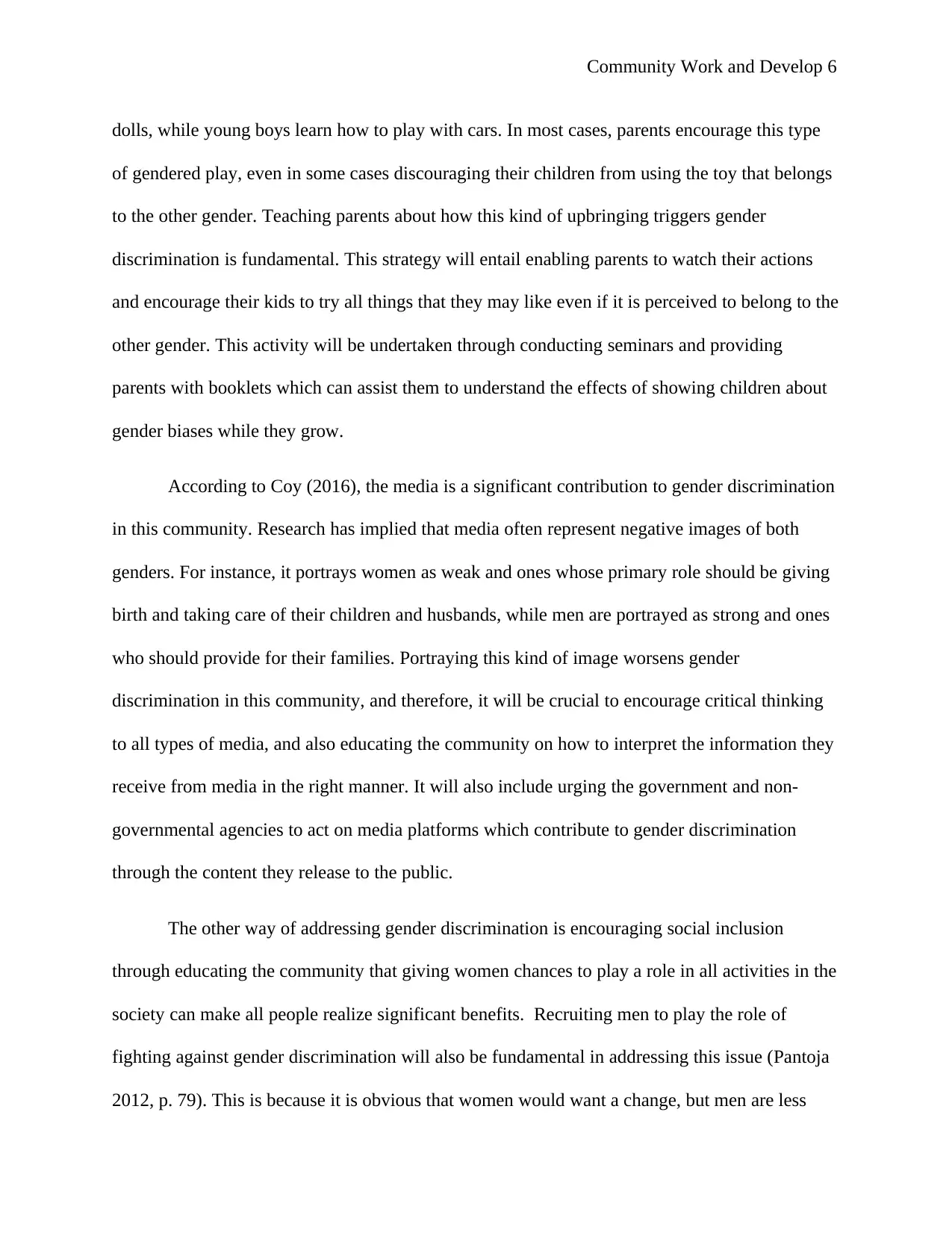
Community Work and Develop 6
dolls, while young boys learn how to play with cars. In most cases, parents encourage this type
of gendered play, even in some cases discouraging their children from using the toy that belongs
to the other gender. Teaching parents about how this kind of upbringing triggers gender
discrimination is fundamental. This strategy will entail enabling parents to watch their actions
and encourage their kids to try all things that they may like even if it is perceived to belong to the
other gender. This activity will be undertaken through conducting seminars and providing
parents with booklets which can assist them to understand the effects of showing children about
gender biases while they grow.
According to Coy (2016), the media is a significant contribution to gender discrimination
in this community. Research has implied that media often represent negative images of both
genders. For instance, it portrays women as weak and ones whose primary role should be giving
birth and taking care of their children and husbands, while men are portrayed as strong and ones
who should provide for their families. Portraying this kind of image worsens gender
discrimination in this community, and therefore, it will be crucial to encourage critical thinking
to all types of media, and also educating the community on how to interpret the information they
receive from media in the right manner. It will also include urging the government and non-
governmental agencies to act on media platforms which contribute to gender discrimination
through the content they release to the public.
The other way of addressing gender discrimination is encouraging social inclusion
through educating the community that giving women chances to play a role in all activities in the
society can make all people realize significant benefits. Recruiting men to play the role of
fighting against gender discrimination will also be fundamental in addressing this issue (Pantoja
2012, p. 79). This is because it is obvious that women would want a change, but men are less
dolls, while young boys learn how to play with cars. In most cases, parents encourage this type
of gendered play, even in some cases discouraging their children from using the toy that belongs
to the other gender. Teaching parents about how this kind of upbringing triggers gender
discrimination is fundamental. This strategy will entail enabling parents to watch their actions
and encourage their kids to try all things that they may like even if it is perceived to belong to the
other gender. This activity will be undertaken through conducting seminars and providing
parents with booklets which can assist them to understand the effects of showing children about
gender biases while they grow.
According to Coy (2016), the media is a significant contribution to gender discrimination
in this community. Research has implied that media often represent negative images of both
genders. For instance, it portrays women as weak and ones whose primary role should be giving
birth and taking care of their children and husbands, while men are portrayed as strong and ones
who should provide for their families. Portraying this kind of image worsens gender
discrimination in this community, and therefore, it will be crucial to encourage critical thinking
to all types of media, and also educating the community on how to interpret the information they
receive from media in the right manner. It will also include urging the government and non-
governmental agencies to act on media platforms which contribute to gender discrimination
through the content they release to the public.
The other way of addressing gender discrimination is encouraging social inclusion
through educating the community that giving women chances to play a role in all activities in the
society can make all people realize significant benefits. Recruiting men to play the role of
fighting against gender discrimination will also be fundamental in addressing this issue (Pantoja
2012, p. 79). This is because it is obvious that women would want a change, but men are less
⊘ This is a preview!⊘
Do you want full access?
Subscribe today to unlock all pages.

Trusted by 1+ million students worldwide
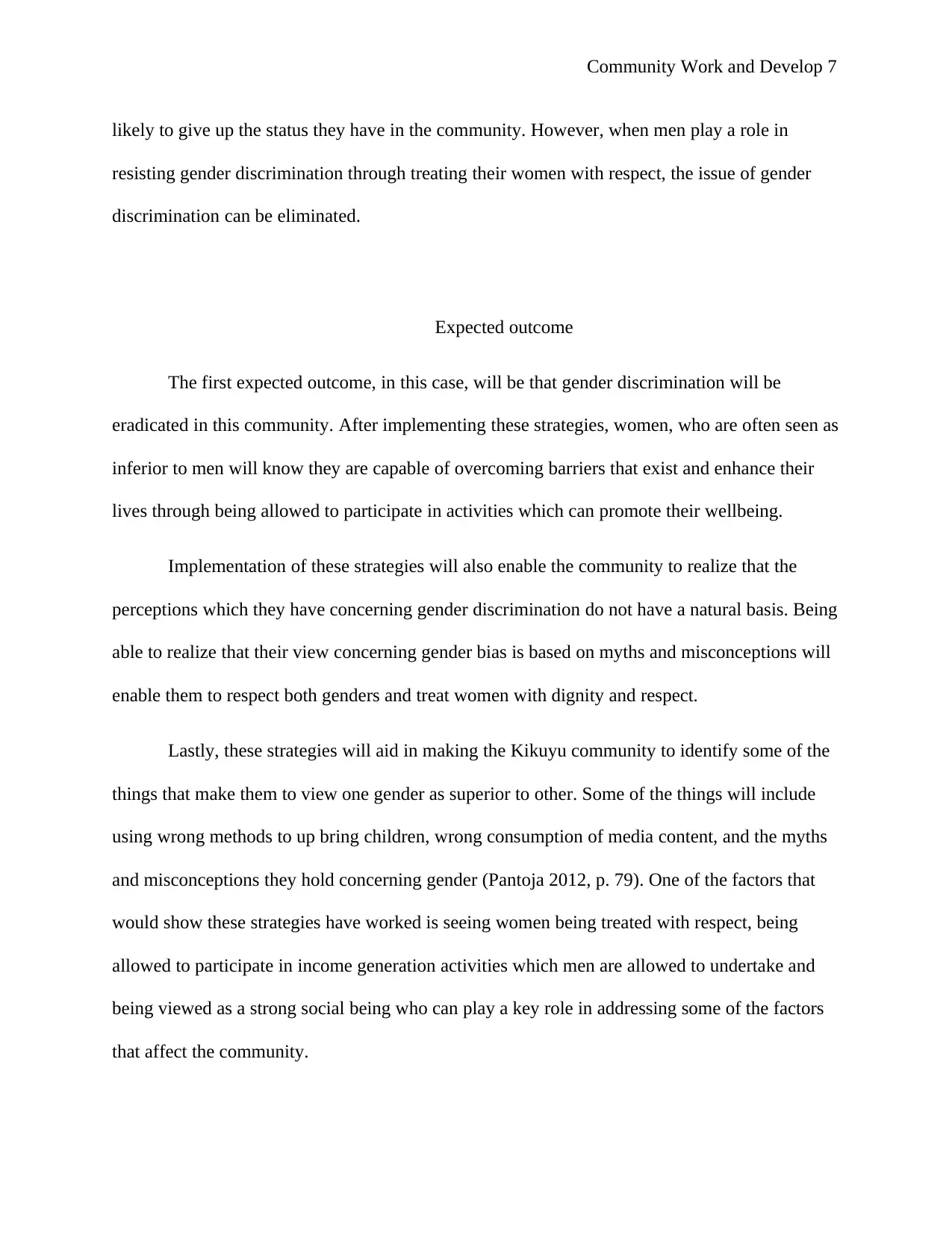
Community Work and Develop 7
likely to give up the status they have in the community. However, when men play a role in
resisting gender discrimination through treating their women with respect, the issue of gender
discrimination can be eliminated.
Expected outcome
The first expected outcome, in this case, will be that gender discrimination will be
eradicated in this community. After implementing these strategies, women, who are often seen as
inferior to men will know they are capable of overcoming barriers that exist and enhance their
lives through being allowed to participate in activities which can promote their wellbeing.
Implementation of these strategies will also enable the community to realize that the
perceptions which they have concerning gender discrimination do not have a natural basis. Being
able to realize that their view concerning gender bias is based on myths and misconceptions will
enable them to respect both genders and treat women with dignity and respect.
Lastly, these strategies will aid in making the Kikuyu community to identify some of the
things that make them to view one gender as superior to other. Some of the things will include
using wrong methods to up bring children, wrong consumption of media content, and the myths
and misconceptions they hold concerning gender (Pantoja 2012, p. 79). One of the factors that
would show these strategies have worked is seeing women being treated with respect, being
allowed to participate in income generation activities which men are allowed to undertake and
being viewed as a strong social being who can play a key role in addressing some of the factors
that affect the community.
likely to give up the status they have in the community. However, when men play a role in
resisting gender discrimination through treating their women with respect, the issue of gender
discrimination can be eliminated.
Expected outcome
The first expected outcome, in this case, will be that gender discrimination will be
eradicated in this community. After implementing these strategies, women, who are often seen as
inferior to men will know they are capable of overcoming barriers that exist and enhance their
lives through being allowed to participate in activities which can promote their wellbeing.
Implementation of these strategies will also enable the community to realize that the
perceptions which they have concerning gender discrimination do not have a natural basis. Being
able to realize that their view concerning gender bias is based on myths and misconceptions will
enable them to respect both genders and treat women with dignity and respect.
Lastly, these strategies will aid in making the Kikuyu community to identify some of the
things that make them to view one gender as superior to other. Some of the things will include
using wrong methods to up bring children, wrong consumption of media content, and the myths
and misconceptions they hold concerning gender (Pantoja 2012, p. 79). One of the factors that
would show these strategies have worked is seeing women being treated with respect, being
allowed to participate in income generation activities which men are allowed to undertake and
being viewed as a strong social being who can play a key role in addressing some of the factors
that affect the community.
Paraphrase This Document
Need a fresh take? Get an instant paraphrase of this document with our AI Paraphraser
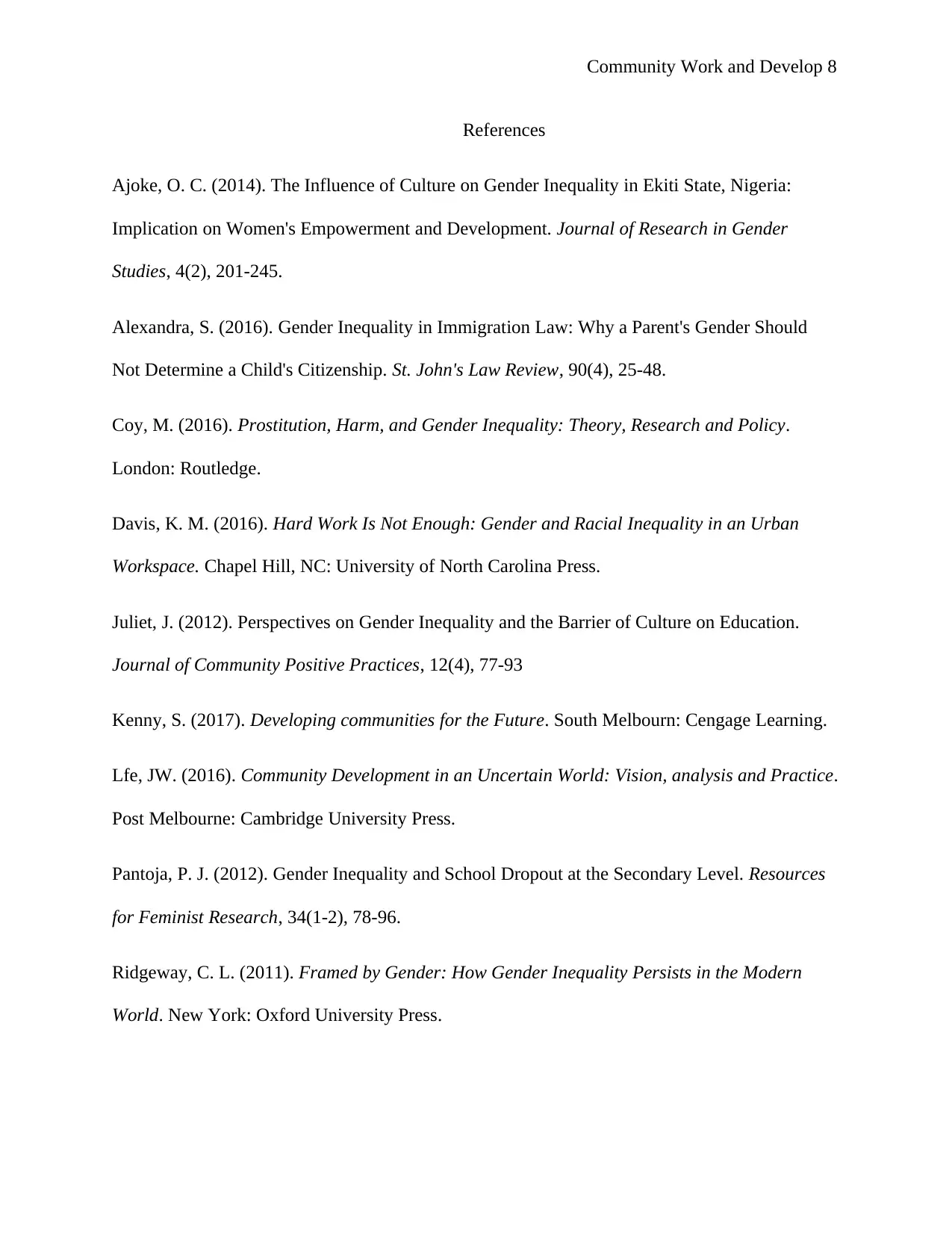
Community Work and Develop 8
References
Ajoke, O. C. (2014). The Influence of Culture on Gender Inequality in Ekiti State, Nigeria:
Implication on Women's Empowerment and Development. Journal of Research in Gender
Studies, 4(2), 201-245.
Alexandra, S. (2016). Gender Inequality in Immigration Law: Why a Parent's Gender Should
Not Determine a Child's Citizenship. St. John's Law Review, 90(4), 25-48.
Coy, M. (2016). Prostitution, Harm, and Gender Inequality: Theory, Research and Policy.
London: Routledge.
Davis, K. M. (2016). Hard Work Is Not Enough: Gender and Racial Inequality in an Urban
Workspace. Chapel Hill, NC: University of North Carolina Press.
Juliet, J. (2012). Perspectives on Gender Inequality and the Barrier of Culture on Education.
Journal of Community Positive Practices, 12(4), 77-93
Kenny, S. (2017). Developing communities for the Future. South Melbourn: Cengage Learning.
Lfe, JW. (2016). Community Development in an Uncertain World: Vision, analysis and Practice.
Post Melbourne: Cambridge University Press.
Pantoja, P. J. (2012). Gender Inequality and School Dropout at the Secondary Level. Resources
for Feminist Research, 34(1-2), 78-96.
Ridgeway, C. L. (2011). Framed by Gender: How Gender Inequality Persists in the Modern
World. New York: Oxford University Press.
References
Ajoke, O. C. (2014). The Influence of Culture on Gender Inequality in Ekiti State, Nigeria:
Implication on Women's Empowerment and Development. Journal of Research in Gender
Studies, 4(2), 201-245.
Alexandra, S. (2016). Gender Inequality in Immigration Law: Why a Parent's Gender Should
Not Determine a Child's Citizenship. St. John's Law Review, 90(4), 25-48.
Coy, M. (2016). Prostitution, Harm, and Gender Inequality: Theory, Research and Policy.
London: Routledge.
Davis, K. M. (2016). Hard Work Is Not Enough: Gender and Racial Inequality in an Urban
Workspace. Chapel Hill, NC: University of North Carolina Press.
Juliet, J. (2012). Perspectives on Gender Inequality and the Barrier of Culture on Education.
Journal of Community Positive Practices, 12(4), 77-93
Kenny, S. (2017). Developing communities for the Future. South Melbourn: Cengage Learning.
Lfe, JW. (2016). Community Development in an Uncertain World: Vision, analysis and Practice.
Post Melbourne: Cambridge University Press.
Pantoja, P. J. (2012). Gender Inequality and School Dropout at the Secondary Level. Resources
for Feminist Research, 34(1-2), 78-96.
Ridgeway, C. L. (2011). Framed by Gender: How Gender Inequality Persists in the Modern
World. New York: Oxford University Press.
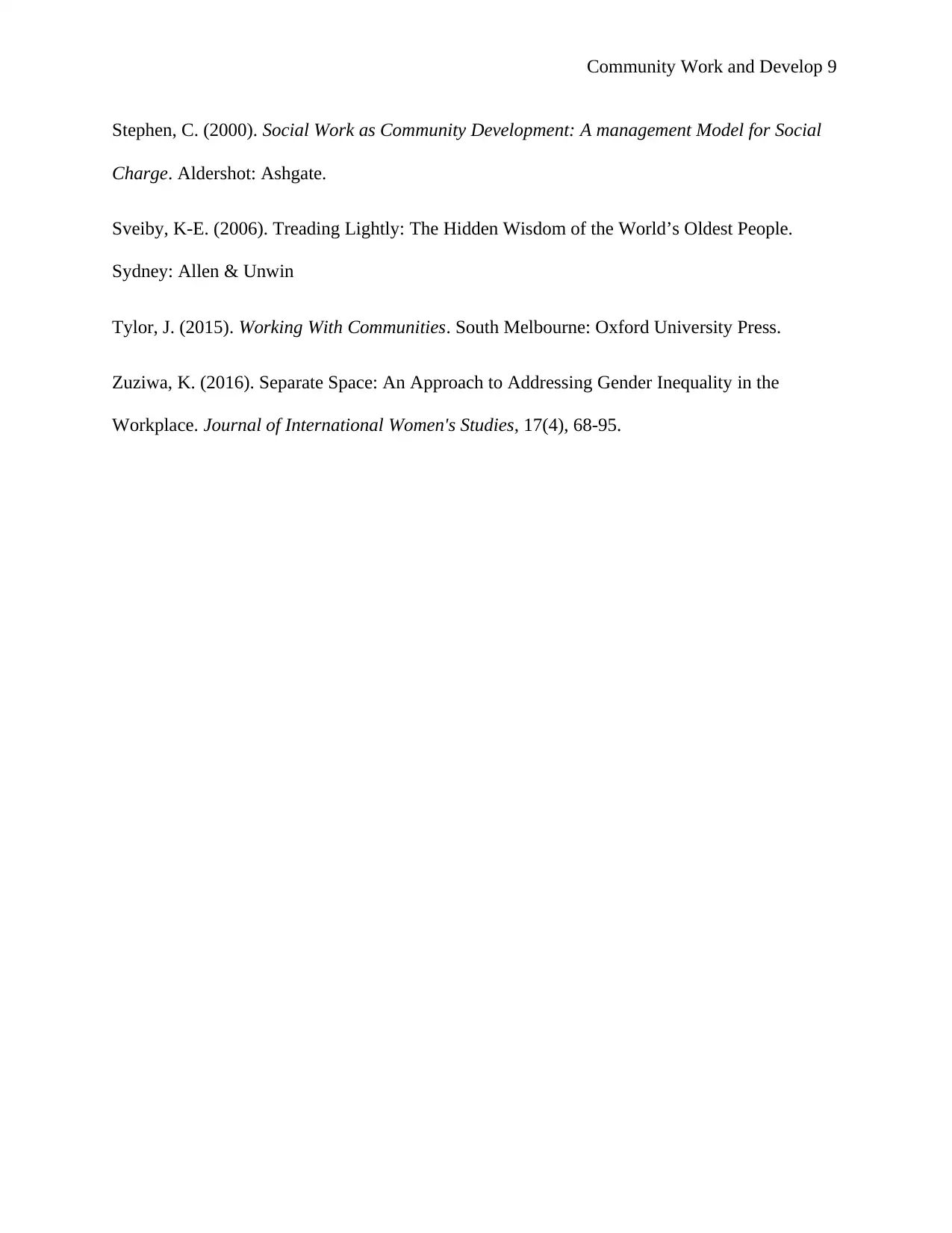
Community Work and Develop 9
Stephen, C. (2000). Social Work as Community Development: A management Model for Social
Charge. Aldershot: Ashgate.
Sveiby, K-E. (2006). Treading Lightly: The Hidden Wisdom of the World’s Oldest People.
Sydney: Allen & Unwin
Tylor, J. (2015). Working With Communities. South Melbourne: Oxford University Press.
Zuziwa, K. (2016). Separate Space: An Approach to Addressing Gender Inequality in the
Workplace. Journal of International Women's Studies, 17(4), 68-95.
Stephen, C. (2000). Social Work as Community Development: A management Model for Social
Charge. Aldershot: Ashgate.
Sveiby, K-E. (2006). Treading Lightly: The Hidden Wisdom of the World’s Oldest People.
Sydney: Allen & Unwin
Tylor, J. (2015). Working With Communities. South Melbourne: Oxford University Press.
Zuziwa, K. (2016). Separate Space: An Approach to Addressing Gender Inequality in the
Workplace. Journal of International Women's Studies, 17(4), 68-95.
⊘ This is a preview!⊘
Do you want full access?
Subscribe today to unlock all pages.

Trusted by 1+ million students worldwide
1 out of 9
Related Documents
Your All-in-One AI-Powered Toolkit for Academic Success.
+13062052269
info@desklib.com
Available 24*7 on WhatsApp / Email
![[object Object]](/_next/static/media/star-bottom.7253800d.svg)
Unlock your academic potential
Copyright © 2020–2025 A2Z Services. All Rights Reserved. Developed and managed by ZUCOL.





